2006 SUBARU TRIBECA load capacity
[x] Cancel search: load capacityPage 209 of 377
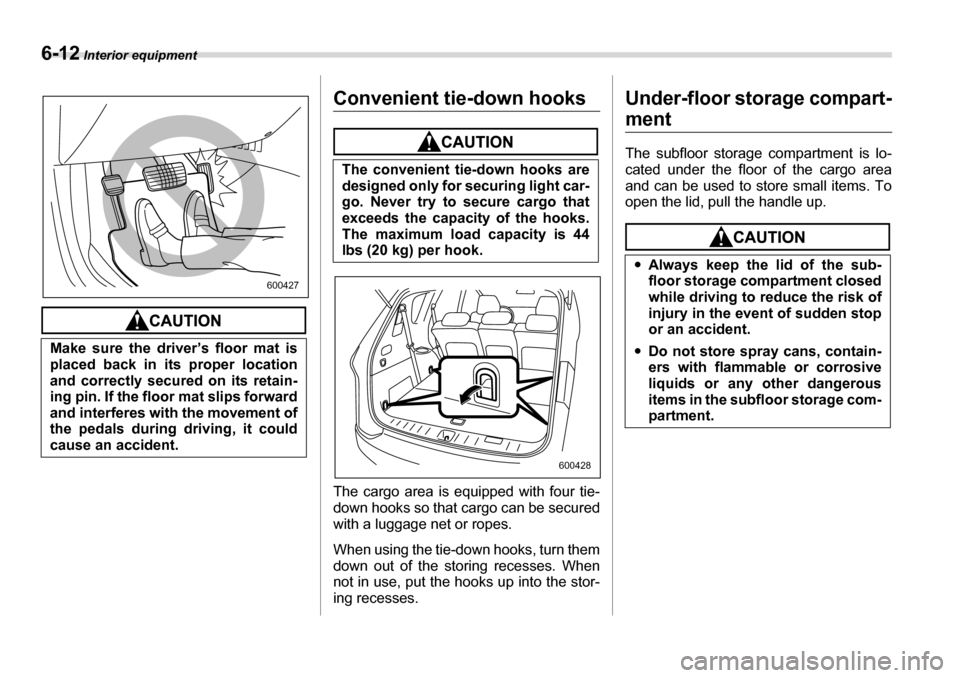
6-12 Interior equipment
Convenient tie-down hooks
The cargo area is equipped with four tie-
down hooks so that cargo can be secured
with a luggage net or ropes.
When using the tie-down hooks, turn them
down out of the storing recesses. When
not in use, put the hooks up into the stor-
ing recesses. Under-floor storage compart-
ment
The subfloor storage compartment is lo-
cated under the floor of the cargo area
and can be used to store small items. To
open the lid, pull the handle up.
Make sure the driver’s floor mat is
placed back in its proper location
and correctly secured on its retain-
ing pin. If the floor mat slips forward
and interferes with the movement of
the pedals during driving, it could
cause an accident.
600427
The convenient tie-down hooks are
designed only for securing light car-
go. Never try to secure cargo that
exceeds the capacity of the hooks.
The maximum load capacity is 44
lbs (20 kg) per hook.
600428
�y
Always keep the lid of the sub-
floor storage compartment closed
while driving to reduce the risk of
injury in the event of sudden stop
or an accident.
�y Do not store spray cans, contain-
ers with flammable or corrosive
liquids or any other dangerous
items in the subfloor storage com-
partment.
Page 246 of 377
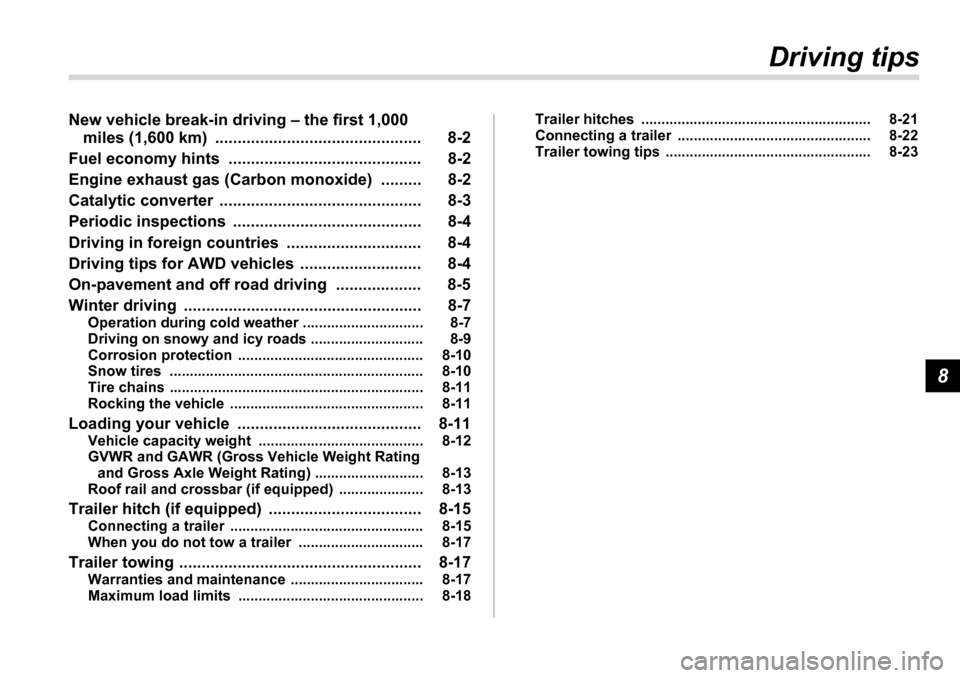
8
Driving tips
New vehicle break-in driving – the first 1,000 miles (1,600 km) .............................................. 8-2
Fuel economy hints ........................................... 8-2
Engine exhaust gas (Carbon monoxide) ......... 8-2
Catalytic converter ............................................. 8-3
Periodic inspections .......................................... 8-4
Driving in foreign countries .............................. 8-4
Driving tips for AWD vehicles ........................... 8-4
On-pavement and off road driving ................... 8-5
Winter driving ..................................................... 8-7 Operation during cold weather .............................. 8-7
Driving on snowy and icy roads ............................ 8-9
Corrosion protection .............................................. 8-10
Snow tires ............................................................... 8-10
Tire chains ............................................................... 8-11
Rocking the vehicle ................................................ 8-11
Loading your vehicle ......................................... 8-11 Vehicle capacity weight ......................................... 8-12
GVWR and GAWR (Gross Vehicle Weight Rating and Gross Axle Weight Rating) ........................... 8-13
Roof rail and crossbar (if equipped) ..................... 8-13
Trailer hitch (if equipped) .................................. 8-15 Connecting a trailer ................................................ 8-15
When you do not tow a trailer ............................... 8-17
Trailer towing ...................................................... 8-17 Warranties and maintenance ................................. 8-17
Maximum load limits .............................................. 8-18 Trailer hitches ......................................................... 8-21
Connecting a trailer ................................................ 8-22
Trailer towing tips ................................................... 8-23
Page 252 of 377
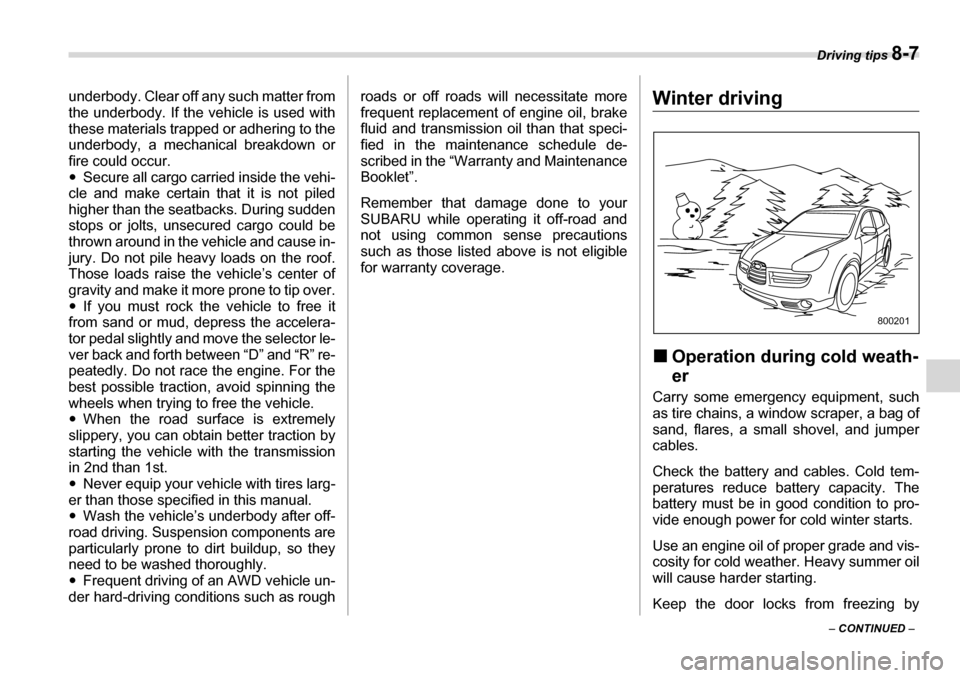
Driving tips 8-7
– CONTINUED –
underbody. Clear off any such matter from
the underbody. If the vehicle is used with
these materials trapped or adhering to the
underbody, a mechanical breakdown or
fire could occur. �y
Secure all cargo carried inside the vehi-
cle and make certain that it is not piled
higher than the seatbacks. During sudden
stops or jolts, unsecured cargo could be
thrown around in the vehicle and cause in-
jury. Do not pile heavy loads on the roof.
Those loads raise the vehicle’s center of
gravity and make it more prone to tip over. �y If you must rock the vehicle to free it
from sand or mud, depress the accelera-
tor pedal slightly and move the selector le-
ver back and forth between “D” and “R” re-
peatedly. Do not race the engine. For the
best possible traction, avoid spinning the
wheels when trying to free the vehicle. �y When the road surface is extremely
slippery, you can obtain better traction by
starting the vehicle with the transmission
in 2nd than 1st. �y Never equip your vehicle with tires larg-
er than those specified in this manual. �y Wash the vehicle’s underbody after off-
road driving. Suspension components are
particularly prone to dirt buildup, so they
need to be washed thoroughly. �y Frequent driving of an AWD vehicle un-
der hard-driving conditions such as rough roads or off roads will necessitate more
frequent replacement of engine oil, brake
fluid and transmission oil than that speci-
fied in the maintenance schedule de-
scribed in the “Warranty and Maintenance Booklet”.
Remember that damage done to your
SUBARU while operating it off-road and
not using common sense precautions
such as those listed above is not eligible for warranty coverage.
Winter driving �„
Operation during cold weath- er
Carry some emergency equipment, such
as tire chains, a window scraper, a bag of
sand, flares, a small shovel, and jumper cables.
Check the battery and cables. Cold tem-
peratures reduce battery capacity. The
battery must be in good condition to pro-
vide enough power for cold winter starts.
Use an engine oil of proper grade and vis-
cosity for cold weather. Heavy summer oil
will cause harder starting.
Keep the door locks from freezing by
800201
Page 257 of 377
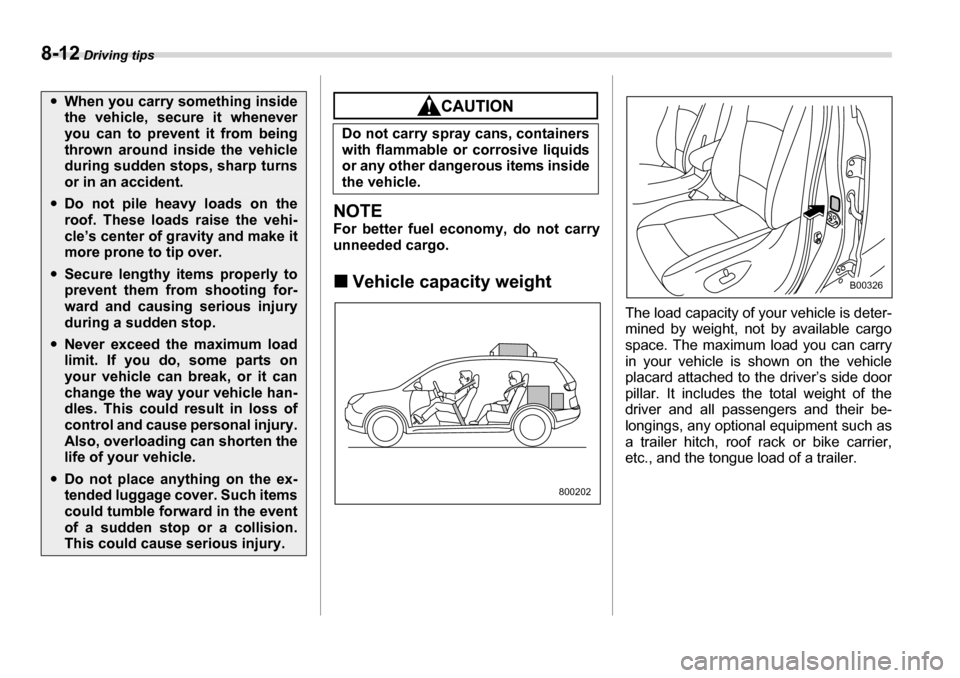
8-12 Driving tips
NOTE
For better fuel economy, do not carry
unneeded cargo. �„Vehicle capacity weight
The load capacity of your vehicle is deter-
mined by weight, not by available cargo
space. The maximum load you can carry
in your vehicle is shown on the vehicle
placard attached to the driver’s side door
pillar. It includes the total weight of the
driver and all passengers and their be-
longings, any optional equipment such as
a trailer hitch, roof rack or bike carrier,
etc., and the tongue load of a trailer.
�yWhen you carry something inside
the vehicle, secure it whenever
you can to prevent it from being
thrown around inside the vehicle
during sudden stops, sharp turns
or in an accident.
�yDo not pile heavy loads on the
roof. These loads raise the vehi-
cle’s center of gravity and make it
more prone to tip over.
�ySecure lengthy items properly to
prevent them from shooting for-
ward and causing serious injury
during a sudden stop.
�yNever exceed the maximum load
limit. If you do, some parts on
your vehicle can break, or it can
change the way your vehicle han-
dles. This could result in loss of
control and cause personal injury.
Also, overloading can shorten the
life of your vehicle.
�yDo not place anything on the ex-
tended luggage cover. Such items
could tumble forward in the event
of a sudden stop or a collision.
This could cause serious injury.
Do not carry spray cans, containers
with flammable or corrosive liquids
or any other dangerous items inside
the vehicle.
800202
B00326
Page 258 of 377
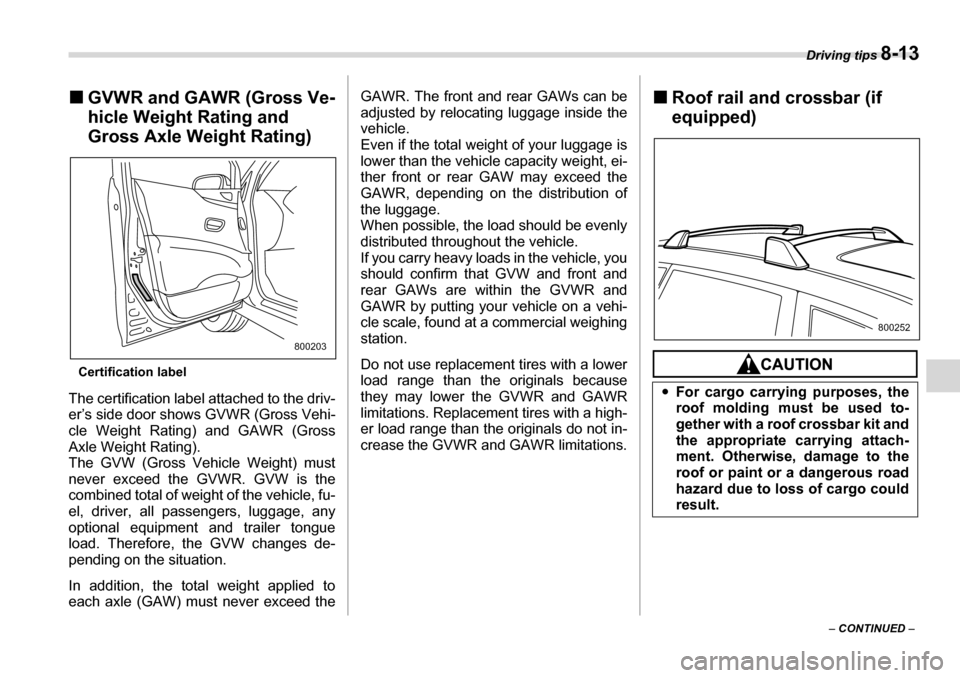
Driving tips 8-13
– CONTINUED –
�„
GVWR and GAWR (Gross Ve-
hicle Weight Rating and
Gross Axle Weight Rating)
Certification label
The certification label attached to the driv-
er’s side door shows GVWR (Gross Vehi-
cle Weight Rating) and GAWR (Gross
Axle Weight Rating).
The GVW (Gross Vehicle Weight) must
never exceed the GVWR. GVW is the
combined total of weight of the vehicle, fu-
el, driver, all passengers, luggage, any
optional equipment and trailer tongue
load. Therefore, the GVW changes de-
pending on the situation.
In addition, the total weight applied to
each axle (GAW) must never exceed the GAWR. The front and rear GAWs can be
adjusted by relocating luggage inside the vehicle.
Even if the total weight of your luggage is
lower than the vehicle capacity weight, ei-
ther front or rear GAW may exceed the
GAWR, depending on the distribution of
the luggage.
When possible, the load should be evenly
distributed throughout the vehicle.
If you carry heavy loads in the vehicle, you
should confirm that GVW and front and
rear GAWs are within the GVWR and
GAWR by putting your vehicle on a vehi-
cle scale, found at a commercial weighingstation.
Do not use replacement tires with a lower
load range than the originals because
they may lower the GVWR and GAWR
limitations. Replacement tires with a high-
er load range than the originals do not in-
crease the GVWR and GAWR limitations.
�„
Roof rail and crossbar (if
equipped)
800203
�yFor cargo carrying purposes, the
roof molding must be used to-
gether with a roof crossbar kit and
the appropriate carrying attach-
ment. Otherwise, damage to the
roof or paint or a dangerous road
hazard due to loss of cargo could
result.
800252
Page 268 of 377
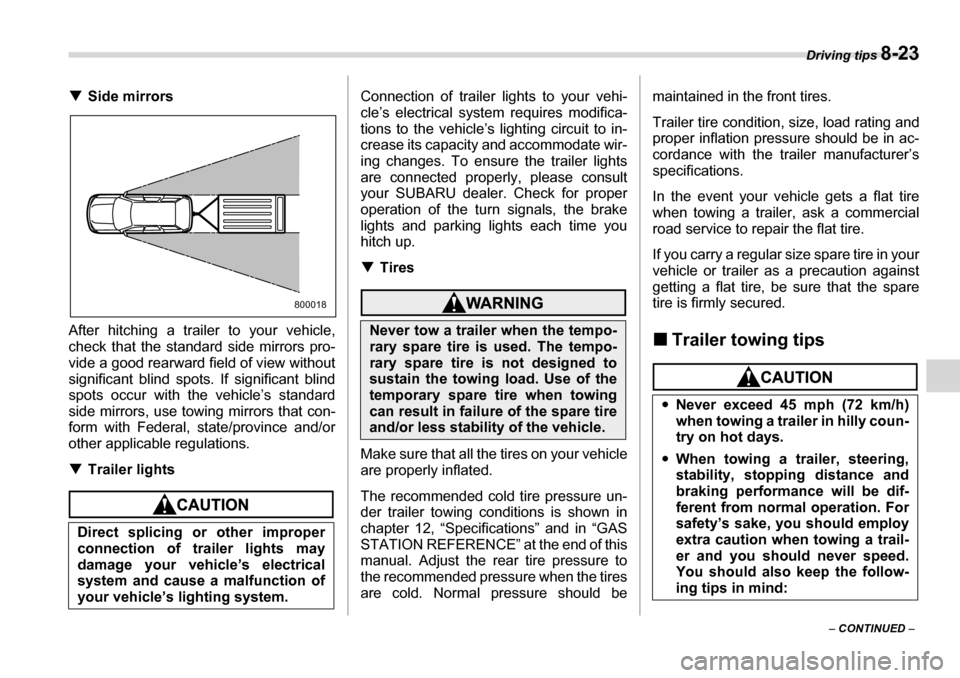
Driving tips 8-23
– CONTINUED –
�T
Side mirrors
After hitching a trailer to your vehicle,
check that the standard side mirrors pro-
vide a good rearward field of view without
significant blind spots. If significant blind
spots occur with the vehicle’s standard
side mirrors, use towing mirrors that con-
form with Federal, state/province and/or
other applicable regulations. �T Trailer lights
Connection of trailer lights to your vehi-
cle’s electrical system requires modifica-
tions to the vehicle’s lighting circuit to in-
crease its capacity and accommodate wir-
ing changes. To ensure the trailer lights
are connected properly, please consult
your SUBARU dealer. Check for proper
operation of the turn signals, the brake
lights and parking lights each time you
hitch up. �TTires
Make sure that all the tires on your vehicle
are properly inflated.
The recommended cold tire pressure un-
der trailer towing conditions is shown in
chapter 12, “Specifications” and in “GAS
STATION REFERENCE” at the end of this
manual. Adjust the rear tire pressure to
the recommended pressure when the tires
are cold. Normal pressure should be maintained in the front tires.
Trailer tire condition, size, load rating and
proper inflation pressure should be in ac-
cordance with the trailer manufacturer’s
specifications.
In the event your vehicle gets a flat tire
when towing a trailer, ask a commercial
road service to repair the flat tire.
If you carry a regular size spare tire in your
vehicle or trailer as a precaution against
getting a flat tire, be sure that the spare
tire is firmly secured. �„
Trailer towing tips
Direct splicing or other improper
connection of trailer lights may
damage your vehicle’s electrical
system and cause a malfunction of
your vehicle’s lighting system.
800018
Never tow a trailer when the tempo-
rary spare tire is used. The tempo-
rary spare tire is not designed to
sustain the towing load. Use of the
temporary spare tire when towing
can result in failure of the spare tire
and/or less stability of the vehicle.
�yNever exceed 45 mph (72 km/h)
when towing a trailer in hilly coun-
try on hot days.
�y When towing a trailer, steering,
stability, stopping distance and
braking performance will be dif-
ferent from normal operation. For
safety’s sake, you should employ
extra caution when towing a trail-
er and you should never speed.
You should also keep the follow-
ing tips in mind:
Page 359 of 377
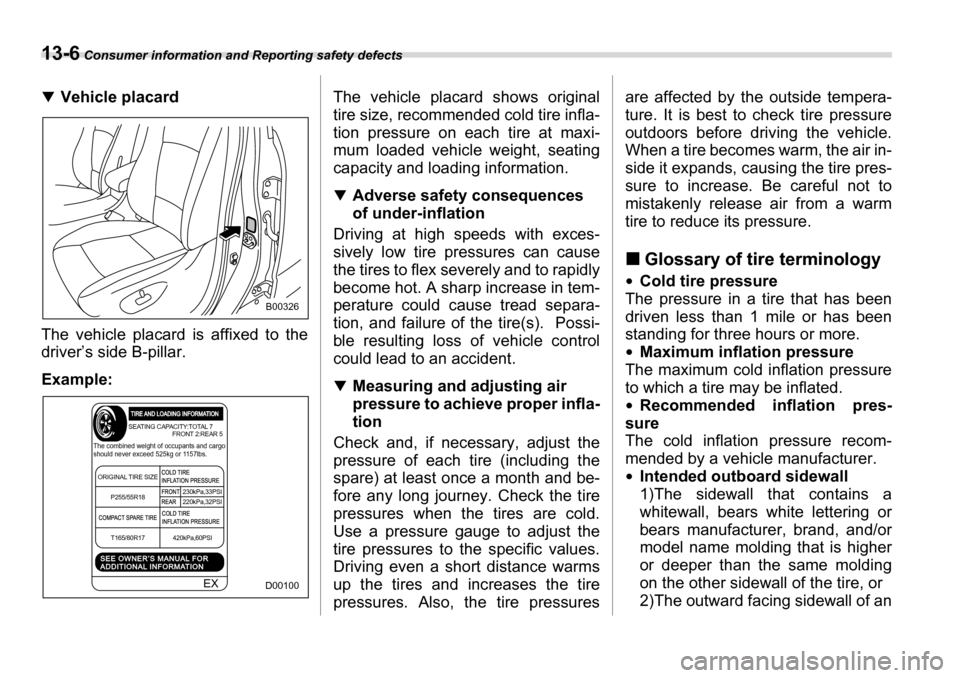
13-6 Consumer information and Reporting safety defects
�TVehicle placard
The vehicle placard is affixed to the
driver’s side B-pillar. Example: The vehicle placard shows original
tire size, recommended cold tire infla-
tion pressure on each tire at maxi-
mum loaded vehicle weight, seating
capacity and loading information. �T
Adverse safety consequences
of under-inflation
Driving at high speeds with exces-
sively low tire pressures can cause
the tires to flex severely and to rapidly
become hot. A sharp increase in tem-
perature could cause tread separa-
tion, and failure of the tire(s). Possi-
ble resulting loss of vehicle control
could lead to an accident. �T Measuring and adjusting air
pressure to achieve proper infla-
tion
Check and, if necessary, adjust the
pressure of each tire (including the
spare) at least once a month and be-
fore any long journey. Check the tire
pressures when the tires are cold.
Use a pressure gauge to adjust the
tire pressures to the specific values.
Driving even a short distance warms
up the tires and increases the tire
pressures. Also, the tire pressures are affected by the outside tempera-
ture. It is best to check tire pressure
outdoors before driving the vehicle.
When a tire becomes warm, the air in-
side it expands, causing the tire pres-
sure to increase. Be careful not to
mistakenly release air from a warm
tire to reduce its pressure. �„
Glossary of tire terminology
�y Cold tire pressure
The pressure in a tire that has been
driven less than 1 mile or has been
standing for three hours or more. �y Maximum inflation pressure
The maximum cold inflation pressure
to which a tire may be inflated. �y Recommended inflation pres-
sure
The cold inflation pressure recom-
mended by a vehicle manufacturer. �y Intended outboard sidewall
1)The sidewall that contains a
whitewall, bears white lettering or
bears manufacturer, brand, and/or
model name molding that is higher
or deeper than the same molding
on the other sidewall of the tire, or
2)The outward facing sidewall of an
B00326
TIREAND LOADING INFORMAANDLOADINGINFORMATIONSEATING CAPACITY:TOTAL 7
ORIGINAL TIRE SIZE COLD TIRE
INFLATION PRESSURE
COLD TIRE
INFLATION PRESSURE
FRONT
230kPa,33PSI
REAR 220kPa,32PSI
P255/55R18
T165/80R17 420kPa,60PSI
COMPACT SPARE TIRE FRONT 2:REAR 5
The combined weight of occupants and cargo
should never exceed 525kg or 1157lbs.
SEE OWNER’S MANUALSEE OWNER’S MANUAL FOR FORADDITIONALADDITIONAL INFORMA INFORMATIONTION
EXD00100
Page 360 of 377
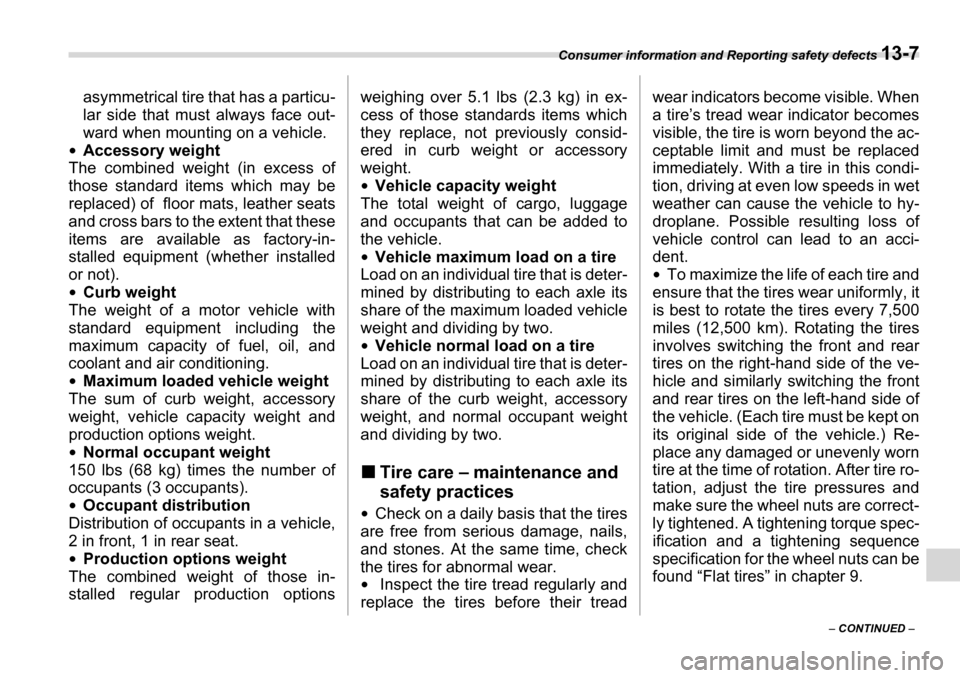
Consumer information and Reporting safety defects 13-7
– CONTINUED –
asymmetrical tire that has a particu-
lar side that must always face out-
ward when mounting on a vehicle.
�y Accessory weight
The combined weight (in excess of
those standard items which may be
replaced) of floor mats, leather seats
and cross bars to the extent that these
items are available as factory-in-
stalled equipment (whether installedor not). �y Curb weight
The weight of a motor vehicle with
standard equipment including the
maximum capacity of fuel, oil, and
coolant and air conditioning.�y Maximum loaded vehicle weight
The sum of curb weight, accessory
weight, vehicle capacity weight and
production options weight. �y Normal occupant weight
150 lbs (68 kg) times the number of
occupants (3 occupants). �y Occupant distribution
Distribution of occupants in a vehicle,
2 in front, 1 in rear seat. �y Production options weight
The combined weight of those in-
stalled regular production options weighing over 5.1 lbs (2.3 kg) in ex-
cess of those standards items which
they replace, not previously consid-
ered in curb weight or accessory
weight. �y
Vehicle capacity weight
The total weight of cargo, luggage
and occupants that can be added to
the vehicle. �y Vehicle maximum load on a tire
Load on an individual tire that is deter-
mined by distributing to each axle its
share of the maximum loaded vehicle
weight and dividing by two. �y Vehicle normal load on a tire
Load on an individual tire that is deter-
mined by distributing to each axle its
share of the curb weight, accessory
weight, and normal occupant weight
and dividing by two. �„ Tire care – maintenance and
safety practices
�y Check on a daily basis that the tires
are free from serious damage, nails,
and stones. At the same time, check
the tires for abnormal wear. �y Inspect the tire tread regularly and
replace the tires before their tread wear indicators become visible. When
a tire’s tread wear indicator becomes
visible, the tire is worn beyond the ac-
ceptable limit and must be replaced
immediately. With a tire in this condi-
tion, driving at even low speeds in wet
weather can cause the vehicle to hy-
droplane. Possible resulting loss of
vehicle control can lead to an acci-
dent. �y
To maximize the life of each tire and
ensure that the tires wear uniformly, it
is best to rotate the tires every 7,500
miles (12,500 km). Rotating the tires
involves switching the front and rear
tires on the right-hand side of the ve-
hicle and similarly switching the front
and rear tires on the left-hand side of
the vehicle. (Each tire must be kept on
its original side of the vehicle.) Re-
place any damaged or unevenly worn
tire at the time of rotation. After tire ro-
tation, adjust the tire pressures and
make sure the wheel nuts are correct-
ly tightened. A tightening torque spec-
ification and a tightening sequence
specification for the wheel nuts can be
found “Flat tires” in chapter 9.